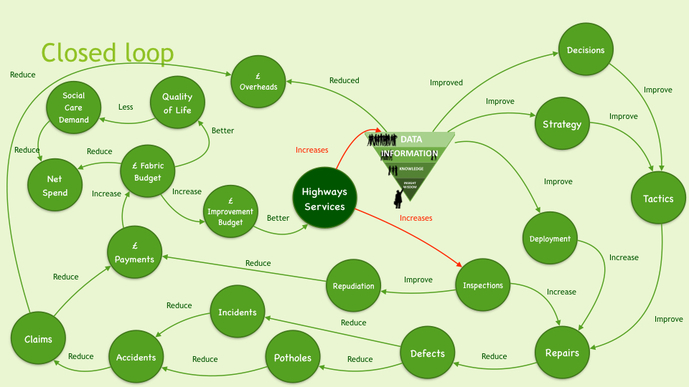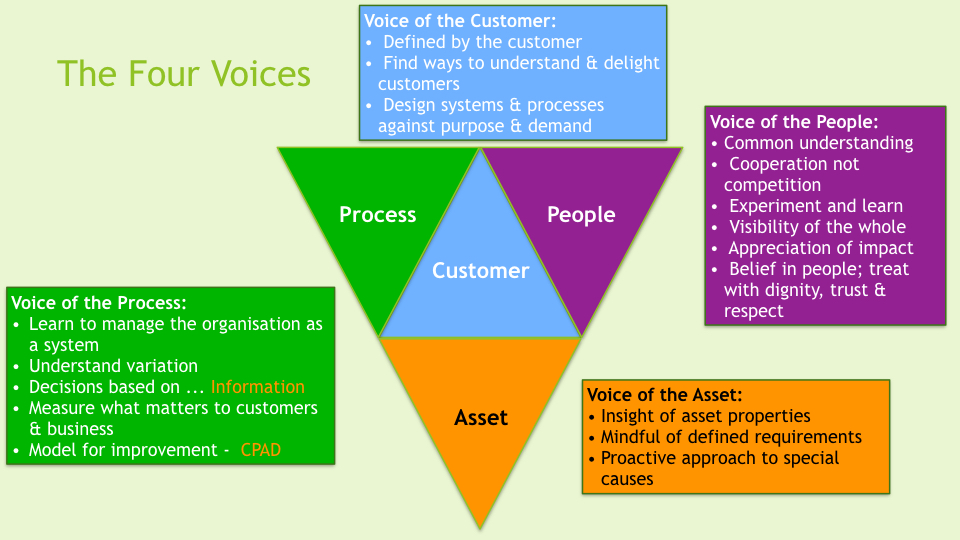
VT- Achieving More for Less (VT-AMfL) is relatively easy to address, via a sensible mix of ‘Lean and Systems Thinking’ methodologies specially designed for the Service and Public Sectors.
If your experience of change and transformation have so far been less than perfect, perhaps it’s because the methodology was either designed for a different situation or was not able to address everyone’s needs. VT-AMfL will be designed for you, and only for you.
Breaking the title down to its elements;
Achieving: This is reliability, always delivering (not just designing) a series of outcomes to meet and exceed requirements for a wide range of stakeholders across an organisation such that they are effective and as near optimal as is pragmatically possible.
More: Enhanced services which enable increased income, better customer experiences, increased employment, better use of assets, increased environmental alignment, improved engagement with: staff, customers and across services. --- Belief and trust for the decision makers in the systems that they are responsible for, information available to everyone in the system in the ways that adds value and meaning to them, speed in the development of ideas and their delivery. Creating more powerful capabilities to improve efficiencies and effectiveness in harmony.
- Cooperation and collaboration: both within the organisation and with others, including contractors, suppliers and parallel organisations, and finally capability to change faster confidently.
Less: Waste within the system and costs to deliver them, complaints and bureaucracy, time from need to delivery, sickness and unrest within the workforce, focus on the HR and Audit controls in case things go wrong, conflicts that lead to uncertainty.
Less - Potholes, Crime, Obesity, Accidents, Claims, Claim-chasers, Unemployment, Ill-health, Journey time, CO2…
Collectively AMfL is a customer centric, scientific way of working, which start from where you are, and what is needed to be delivered. It will embrace all that is good, and will modify/replace all that can be improved, in such a way to enable a rapid return on capital employed, enhancing everything within the system that helps make change easier.
Too good to be true?
AMfL will appear too good to be true because the whole of society is used to failure, it’s what we expect from all organisations and a primary cause of people rarely wanting to either change or buy something that is totally new.
So why would we want to move away from the tried and tested ways of working that have served us so well in the past? For instance, Prince 2 as a change methodology reliably delivers 30% success rate to achieve change. Oh yes, that’s a reliable probability to fail 70% of the time.
Well at least Lean improves part of a service well, achieving a net improvement to around 30% of projects engaged in, or again a 70% failure to achieve sustainable improvements as required from the outset.
So why is it that these internationally adopted ways of working are industry standards?
- Well for one thing when done well; they do deliver
- Most transformation fail due to being under-aware of the whole system issues to address, not creating essential Knowledge.
- They have a constant structure, so should be able to be cloned from place to place!
- Cloning rarely works, such that less than 10% of the service is understood, like the tip of an iceberg.
- They provide a mechanism for procurement, to say we want this to be done this way.
- Most transactions contracts appear to be good, but sub-optimise outcomes.
So far, AMfL has never failed to not only to deliver what was required, but to also exceed requirements, both in terms of time to achieve, and the financial/operational targets to deliver.
Why is that the case?
AMfL is not a singular way of working, other than: It always starts with the client: What do they want? How do they work? What are the current outcomes? What will good feel like? How will that be best designed and communicated?
Visualised information uses 80% of the brain capacity and is the most effective way to communicate of all the senses. VT-AMfL consciously unpacks the psychology of change, utilises models that add context, such as Data>Information>Knowledge>Tactics (D>I>K>T), Transactional Johari, the Voice of the Asset (VotA), Causal and Feedback Loops, Simplicity on the other side of Complexity, Closed Loop Thinking and an appreciation of Neuro-science which all lead to an Organisation that Works Naturally Together with a Leadership that knows where it is going, communicated to all involved to be able to truly engage.
NOTE
Visualising Transformation is a “way of Working’ (WoW) that takes information within a system and translates it into relevant meaning for the people involved, enabling clarity and better, faster decisions. VT-AMfL is the outcome of continuously improving Continual Improvement.
VT-AMfL is a Book designed to navigate an organisation to work naturally together, with a three-day training course called VT – CAUSAL to accelerate it through a cultural change.
We would love to hear you thoughts, for all enquiries contact Dave Gaster at [email protected].


 RSS Feed
RSS Feed